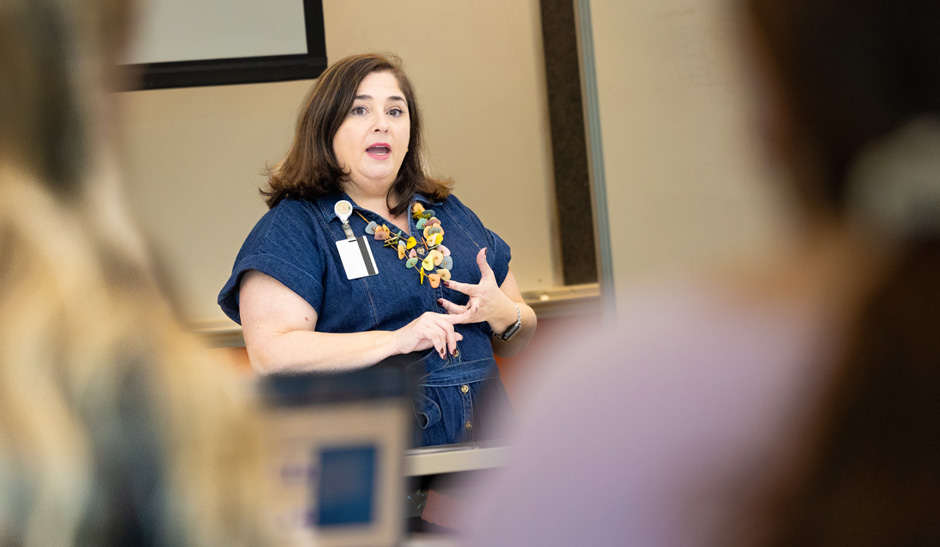In an ever-changing world of technology, educational programs face the challenge of reflecting real-world trends and advancements. The University of Miami School of Communication consistently rises to the challenge, offering a range of courses that integrate modern applications into the communications field.
A standout addition to its curriculum is STC 493-R, a new special topics course in public relations, which is perfect for beginners, as no prior AI experience is required to take the course. As artificial intelligence continues to revolutionize industries and establish itself as a daily tool, the course is designed to teach students the perfect balance between utilizing AI platforms and their own work.
In a rapidly changing world of media, this course represents an opportunity for students to stay ahead of industry trends, adapt to emerging tools, and thrive in the AI-driven world of communications.
Set to debut in the Spring 2025 semester, the course is taught by Marcia Gomez, a lecturer at the School of Communication who has more than 20 years of experience working in media, higher education, the arts and business communities. Gomez’s expertise ensures that students will gain a foundational understanding of the intersection of AI and PR.
Gomez shared her insights into the development of this course and her vision for its impact on both students and the PR industry.
What inspired the development of this course?
The rapid adoption of AI across industries, including PR, highlighted the need for a course that reflects these changes. After experimenting with AI in my existing classes, it became clear that a few lessons couldn’t cover the full scope of its potential. This course was designed to create a dedicated space for students to dive deeply into AI’s role in PR, preparing them not just for the present but for the industry’s future. It’s also an opportunity to explore the exciting tools the industry is starting to utilize.
What specific skills or knowledge will participants gain from this course?
This course equips students with essential skills to navigate AI in PR effectively. They’ll learn to use AI tools for research, content creation, and image generation while mastering prompt engineering to optimize AI outputs. Ethical considerations, like understanding bias and misinformation, will also be a focus. By the end of the course, students will know how to apply AI-driven strategies to enhance PR campaigns and make them smarter and more efficient.
How does the course balance technical AI knowledge with PR-specific applications?
The course begins with basic AI concepts to ensure students understand how the technology works, but the focus is always on its relevance to PR. For instance, students will explore how AI can make media monitoring more efficient, refine audience analysis, and enhance research and campaign planning. This isn’t a course about becoming a coder; it’s about becoming a smarter communicator who knows how to use these tools strategically.
How will this course help rising PR professionals stand out in a competitive industry?
By equipping students with cutting-edge skills, this course helps them stay ahead of industry trends. While some fear AI might replace jobs, those who master these tools will create new opportunities for themselves. Just like the rise of the internet, learning to embrace AI is key to staying competitive and shaping the future of PR.
While AI can seem overwhelming, I want them to see it as something they can master and apply effectively.
What are you hoping to get out of teaching the course?
My goal is to help students feel confident and empowered when using AI. While AI can seem overwhelming, I want them to see it as something they can master and apply effectively. By the end of the course, I hope students will be equipped to think critically, innovate, and use AI ethically in their PR careers.
Why should someone sign up for this course?
AI is transforming industries, including PR. This course provides students with practical experience using the tools making waves in the field. Beyond gaining hands-on skills, students will learn to apply AI effectively and ethically. By the end, students will have a competitive edge in the job market and a strong understanding of emerging industry trends.
What are the biggest challenges PR professionals face when implementing AI into their strategies?
One of the main hurdles is understanding the capabilities and limitations of AI. It can be tricky to integrate these tools into existing workflows without compromising authenticity. Additionally, there are ethical concerns, such as avoiding issues like bias or misinformation. Despite these challenges, the potential benefits make it worth navigating.

How does the course address ethical concerns related to AI in PR?
The course dedicates time to exploring the ethical and legal sides of AI, such as tackling bias, misinformation, and intellectual property concerns. To deepen students’ understanding, industry professionals specializing in these areas will be invited to provide industry insights. The goal is to equip students to use AI responsibly and thoughtfully in their careers.
Are there specific AI tools or platforms that the course emphasizes?
Students will explore a variety of tools, including ChatGPT, Claude, and Perplexity for content creation, as well as MidJourney, Canva, and Beautiful.ai for visual and presentation work. Part of the course’s excitement is discovering and experimenting with new tools as they emerge, making the experience dynamic and forward-looking.
Where do you see AI taking the PR industry in the next 5-10 years?
AI will likely automate routine tasks such as media monitoring and content drafting, freeing up PR professionals to focus more on strategy and creativity. It will also enhance personalization and provide improved data for decision-making. Tools are already emerging that make outreach more targeted, and in the future, AI will be indispensable for real-time insights and crisis management.

